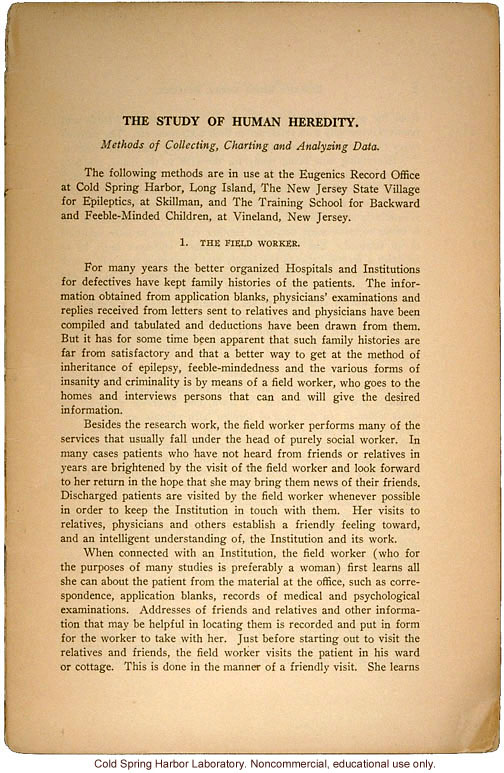The Study of Human Heredity.
Methods of Collecting, Charting and Analyzing Data.
The following methods are in use at the Eugenics Record Office at Cold Spring Harbor, Long Island, The New Jersey State Village for Epileptics, at Skillman, and The Training School for Backward and Feeble-Minded Children, at Vineland, New Jersey.
1 The Field Worker.
For many years the better organized Hospitals and Institutions for defectives have kept family histories of the patients. The information obtained from application blanks, physicians' examinations and replies from letters sent to relatives and physicians have been compiled and tabulated and deductions have been drawn from them. But it has for some time been apparent that such family histories are far from satisfactory and that a better way to get at the method of inheritance of epilepsy, feeble-mindedness and the -various forms of insanity and criminality is by means of a field worker, who goes to the homes and interviews persons that can and will give the desired information.
Besides the research work, the field worker performs many of the services that usually fall under the head of purely social worker. In many cases patients who have not heard from friends or relatives in years are brightened by a visit of the field worker and look forward to her return in hope that she may bring them news of their friends. Discharged patients are visited by the field worker whenever possible in order to keep the Institution in touch with them. Her visits to relatives, physicians and others establish a friendly feeling toward, and an intelligent understanding of, the Institution and its work.
When connected with an Institution, the field worker (who for the purposes of many studies is preferably a woman) first learns all she can about the patient from the material at the office, such as correspondence, application blanks, records of medical and psychological examinations. Addresses of friends and relatives and other information that may be helpful in locating them is recorded and put in form for the worker to take with her. Just before starting out to visit the relatives and friends, the field worker visits the patient in his ward or cottage. This is done in the manner of a friendly visit. She learns
[end]


